Conditioning training is a ‘buzzword’ that is often interchanged with the word ‘fitness.’ You’ll often hear martial artists and fighters talk about what they do for conditioning, or will finish their training with extra conditioning on the mats usually consisting of running or circuit training. Outside of fight training, their martial arts conditioning may involve road running, hill sprints, suicide runs, and every endurance activity in-between.
But why does conditioning only refer to ‘fitness?’ I’d assume it’s because of the rise in popularity of the term ‘strength and conditioning’ where strength refers to what you do in the gym and conditioning refers to what you do outside of it. However, to get conditioned for your sport, it is more than just ‘fitness.’
Conditioning training refers to being conditioned for the sport. That means being able to throw a volume of strikes without gassing out, or holding strong isometric grip and leg contractions during grappling without fatiguing. That means being conditioned, and the subsequent conditioning training, is going to be different for different sports and martial arts.

How to Dominate Every Fight with Raw, Explosive Power No One Can Match
Discover the underground blueprint that has quietly turned MMA hopefuls into legends, using nothing but sheer, brute force and bulletproof conditioning techniques.
If conditioning is more than just ‘fitness’ or energy system development, then how should you prepare for striking or grappling?
How To Condition For MMA
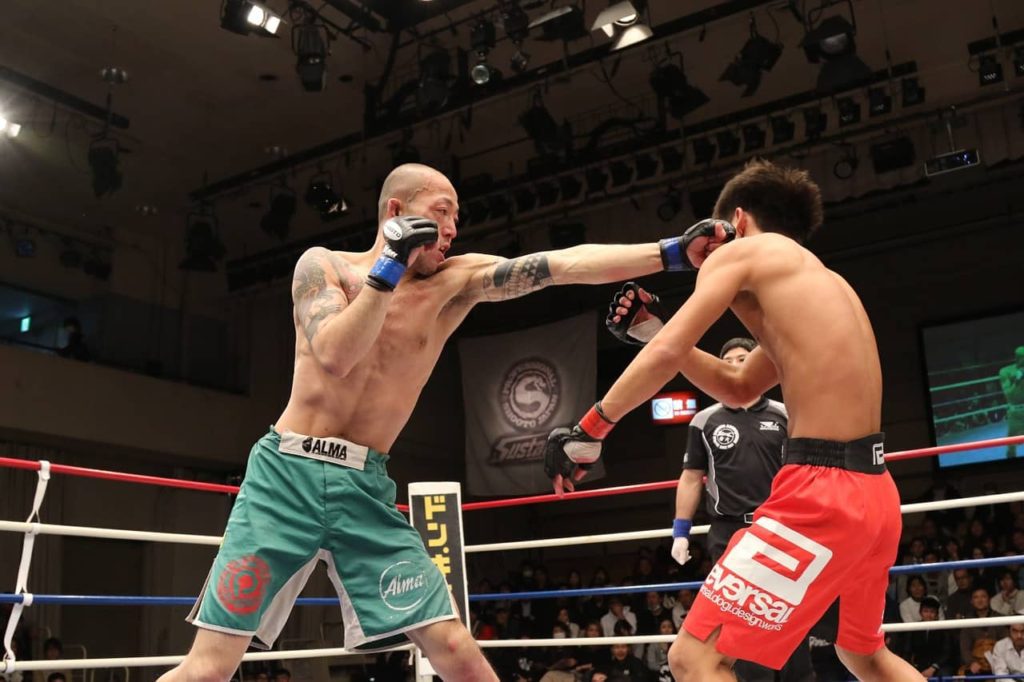
MMA provides the fighter with far more conditioning options than a traditional striker or grappler. This is because of the multiple disciplines an MMA fighter has to train each week. It would make sense then to use extra physical preparation time to further develop the technical skills needed to succeed in MMA. These being striking, grappling, and a combination of both.
Much of the research analyzing MMA bouts are from prior to 2015. MMA is a fast-evolving sport. So while these are older data sets, they can still be applicable to today’s competitive MMA with a sprinkling of the new MMA bout analysis.
Professional MMA requires intermittent bouts of high-intensity activity (scrambles, combinations, takedowns, etc) interspersed with low-intensity activity (clinch work, grappling, etc) with a 1:3 to 1:4 high/low-intensity ratio [1,2].
This means to be conditioned for a professional MMA bout, specifically in the UFC, you must be able to handle this workload over a three or five-round match.
This can be broken down even further into stand-up and groundwork. According to a 2015 investigation, regardless of weight class, stand-up doesn’t seem to drop below a 1:7 high/low-intensity ratio regardless of the round [3].
However, groundwork stays a steady 1:1 high/low-intensity ratio regardless of weight class or round.
This is likely because fighters have to work on the ground in order to not be stood up. Conditioning for groundwork in MMA requires preparing fighters to be able to handle high-intensity bursts with equals rest with high-intensity efforts ranging from 35 sec to 75 sec on average.
Conditioning for stand up is being prepared for 12 sec to 24 sec of high intensity activity with up to seven times the length in low intensity activity such as clinch work [3].
The modalities used for conditioning are very important to a fighter’s preparation. Many may read this and think they can perform these work to rest ratios on an airdyne or while performing sprints. However, conditioning comes down to performing the specific high and low-intensity actions that will occur in the MMA bout.
This means gradually increasing the number of high and low-intensity striking, takedowns, and grappling and performing actions shorter and longer than the average time.
For example, a 6-8 sec flurry of strikes then shoot for a double leg and complete the takedown. Followed by 30-sec low-intensity top control, then 30-70 sec scramble or work to mount. Scenarios and drills can be endless. This would be the end goal to aim for to simulate a fight.
Before that, it’s about building the gas tank and stoking the fire. Performing long-duration, steady-state drills is a great way of building-specific work capacity. For example, 20-40 min straight on the heavy bag. Throwing the same volume and intensity of strikes throughout time. The same could be done with groundwork drilling submissions and sweeps in a continuous fashion.
It’s important to note that these are averages. Using the average as a training prescription isn’t going to optimize conditioning for MMA. It’s about developing long, slow, sustained endurance along with maximizing the high-intensity outputs. Then it is about bringing them together and looking at worst-case scenarios in fights.
Sadly, the worst case scenario of high:low intensity activity hasn’t been investigated in the literature. However, you could work this out for your athletes or yourself by simply watching your fight footage with a stopwatch.
Simply calculate each time a high-intensity activity happens and the same with low-intensity activity. You may uncover that in some fights, you have high-intensity efforts that last much longer than the average. That means you’ll have to prepare for that.
How To Condition For The Striking Arts
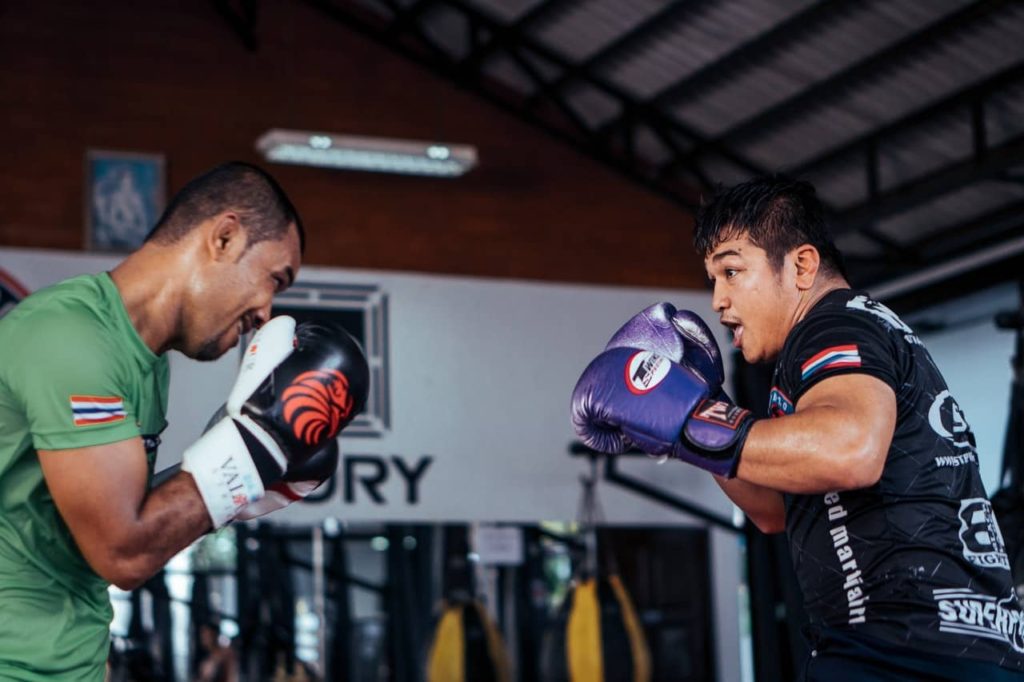
Being conditioned for striking is about being able to throw and receive strikes at a high enough volume and intensity for the duration of the bout. Firstly, let’s start with boxing. For a sport with such a rich history, there hasn’t been much research in the area of breaking down a boxing match.
However, one 2016 study did just that at the World Boxing Championships. They found that there was a 1:2 ratio of active to inactive phases throughout the fight. Active phases were defined as punches while inactive phases were defined as any other activity such as footwork. An active phase lasts for around 2 seconds meaning inactivity lasts approximately 4 seconds. That means a boxer is either throwing or receiving a punch every 4 seconds on average during a fight [4].
One round lasts 180 seconds in boxing. Dividing this by 6 sec allows 30 active and inactive activity bouts in around.
Kickboxing is slightly more active than boxing where a 1:1 ratio of high to low-intensity activity is present in elite male kickboxers. This breaks down to 2-4 sec of intense striking followed by 3-5 sec of movements such as footwork [5]. Muay Thai seems to follow a similar activity profile [9].
Karate is the most active showing a 2:1 activity to break ratio which translates to 18 sec of activity and 9-sec break phases. Over a fight, 16 high-intensity actions are performed on average lasting 1-3 sec, translating to 3 high-intensity actions per minute [6].
However, newer research in top-level karatekas shows an activity to break ratio of 1:1.5 with high-intensity actions showing a ratio of 1:8. This translated to 8 high-intensity actions per minute. The difference in the analysis is likely due to the conditions of karate combat, where a 2:1 activity to break ratio occurred during a simulated match whereas the 1:1.5 ratio occurred in World Championship competition [7].
It would seem, simulated matches offer greater activity but less high-intensity actions. Meaning simulated matches may not adequately prepare karatekas for high-level competition.
International level WTF Taekwondo has the lowest activity ratio with 1:6 fighting to non-fighting activity [8] with only 1.7-sec fighting.
These averages can be guidelines to base your striking conditioning off of. For example, designing a training session for kickboxing could be 3 sec of high intensity striking with 4 sec of footwork repeated over a round.
How To Condition For The Grappling Arts
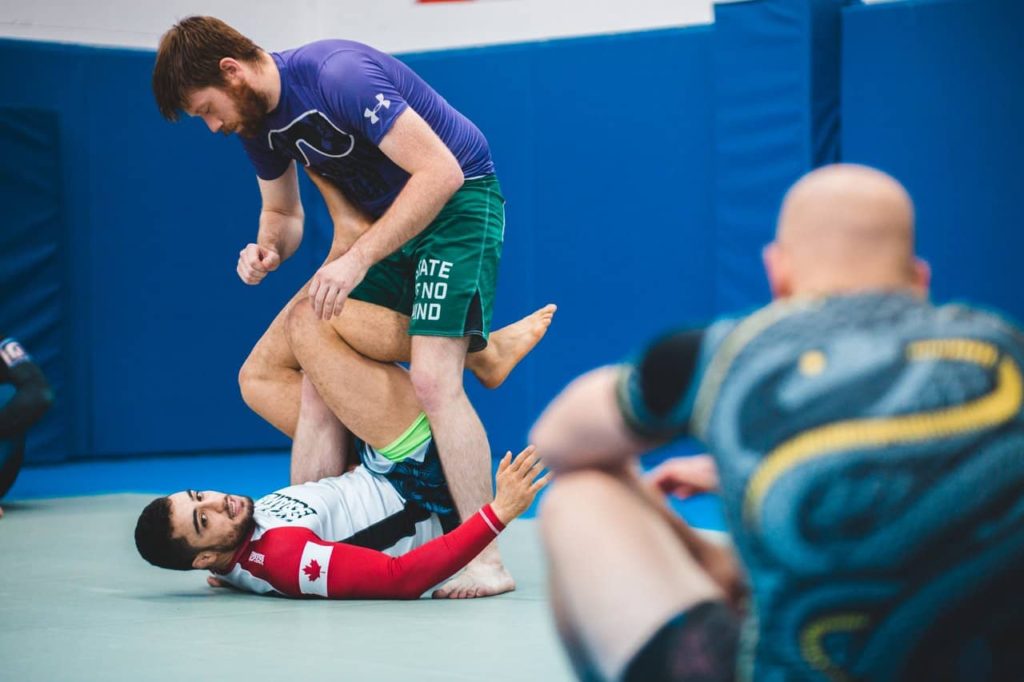
Conditioning for the grappling arts is more than just being ‘fit’ enough to compete multiple times in a day. It’s also developing the muscular endurance to tolerate prolonged exposures of gripping and whole-body tension. Let’s start by looking at Brazilian Jiu-Jitsu.
BJJ has the highest effort to pause ratio of 6:1 making it the grappling sport with the most activity [10]. This translates to 117 sec of effort with 20 sec of pause inactivity. Effort can be further broken down into approximately 30 sec of low intensity and 2-4 sec of high-intensity activity [11].
Grip endurance is a large factor in BJJ and a 15% decline is normal after a 5 min match. It is not maximal grip strength that is important in BJJ, as BJJ practitioners don’t display huge feats of grip strength. Rather, it is the ability to maintain a high percentage of their maximum grip strength [10].
Judo on the other hand has a 2:1 to 3:1 effort to pause ratio with 20-30 sec of efforts separated by 10-sec pauses. This can be further broken down into time spent in a preparation period (before grip fighting) of 4 sec, grip disputes lasting 16-18 sec, attacks lasting 1 sec, and groundwork lasting 9-17 sec. This goes to show the importance of having a well-conditioned grip as grip disputes represent 58% of all stand-up time [12].
Wrestling averages a 2.5:1 effort to pause ratio similar to Judo. However, efforts last a little longer on average at 37 sec with 14 sec of pauses [13]. The shoulders and biceps suffer from the greatest fatigue and need to be conditioned to handle the rigors of wrestling.
Muay Thai has an effort to pause ratio of 2:3 where on average, 9 seconds of activity are interspersed with 12 seconds of observation and preparation.
MMA athletes need to be able to maintain a 1:2 to 1:4 high-intensity activity to low-intensity activity ratio. While Karateka shows a 1:1 to 1:2 activity to break ratio with a 1-5 second high-intensity effort within a 6-11 second activity period is interspersed with a 5-17 second break.
Boxers are some of the “fittest” martial artists having gas tanks similar to those of elite triathletes. They display an activity to break ratio of 18:1 with an average of 1.2 to 1.4 actions per second and 32 punches per minute.
Conditioning And Energy System Development
While I’ve covered the demands of most martial arts, a physiological approach can also be taken when it comes to conditioning training. Conditioning is often broken down into energy systems. You are probably familiar with the terms aerobic and anaerobic. Meaning with oxygen and without oxygen respectively.
Now that doesn’t mean the anaerobic energy system only works when you don’t breathe. It just means the process that occurs in the body doesn’t require oxygen to regenerate energy.
The anaerobic energy system can be broken down further into the anaerobic lactic and anaerobic alactic (which will now be referred to as alactic) energy systems.
The alactic energy system is the most powerful lasting only approximately 10sec. Think of a 100m sprinter who will predominantly use energy from the alactic energy system or shooting for a takedown.
That doesn’t mean 10 seconds of walking empties your alactic energy stores. The intensity of exercise will dictate where the energy is supplied predominantly from.
The anaerobic lactic system lasts up to approximately 90sec. Think of an all-out scramble when grappling.
Finally, the aerobic energy system lasts for hours. It is where most of your energy regeneration will come from when fighting.
It’s important to note that these energy systems are not used in isolation. You can’t flip a switch and suddenly be only anaerobic or only aerobic. They will all work to varying degrees but certain energy systems predominantly supply energy depending on the intensity and duration of the exercise being performed.
It is commonly thought that exercise up to a certain time, say 60 sec, is anaerobic in nature. However, this is not true as it is the intensity that will dictate which energy system is dominant.
When taking an energy systems approach to combat training, many fighters take an interval training approach. Likely because it mimics similar timings to fight rounds and the publicized research stating that high-intensity interval training can elicit better results than long slow endurance training in short training periods (think Tabata).
However, this approach misses the point. The point that certain intensities elicit specific adaptations. Only using high-intensity interval training robs the fighter of important adaptations that come from lower intensity modalities. And same with higher intensity adaptations.
The Importance Of The Aerobic Energy System
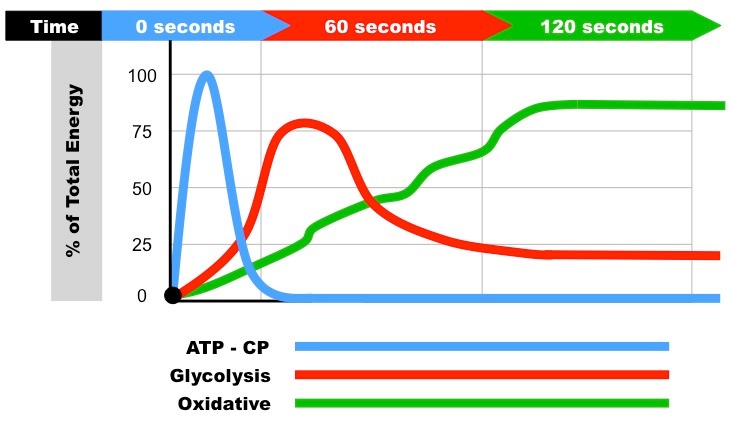
The aerobic energy system plays the greatest role in the ability to recover between high-intensity actions, rounds, and fights [14]. A highly trained aerobic energy system will allow you to maintain a higher level of effort in an aerobic state. Why is this important?
Once you move past your anaerobic threshold (think of this as your upper ceiling of where your aerobic energy system meets your anaerobic energy system), energy has to be pulled from the anaerobic energy system which, while it is powerful, only lasts a fraction of the time.
While never gassing out in a fight is about pacing and efficient use of energy, a well-developed aerobic energy system will allow a fighter to work at higher intensities under the anaerobic threshold.
This is often what is seen when people say a fighter has great conditioning. They’re able to work harder than others without increasing the contribution of their anaerobic lactic system.
Aerobic adaptations occur peripherally (muscles) and centrally (heart and lungs). A well-developed fighter will be able to deliver a lot of oxygen to the working muscles (central adaptations) and have the ability to utilize that oxygen efficiently (peripheral adaptations).
While these adaptations can be targeting using an interval training approach, the problem occurs when the ability to recover from these higher intensity efforts alongside combat sports training.
Low-intensity exercise is able to stimualte aerobic adaptations without pushing an athlete towards potential overtraining.
So how can you target specific central and peripheral aerobic adaptations?
Central aerobic adaptations
Long, slow, steady state cardio. E.g. long run, shadowboxing, grappling drills w/ heart rate between 130-150 BPM.
Cardiac power intervals. E.g. 60-sec maximum effort w/ heart rate recovery of 120-130 BPM [15].
Peripheral aerobic adaptations
Sled drags or Hill sprints. 15×10 sec sprint w/ heart rate recovery between 130-140 BPM.
Resistance training with tempo. E.g. squatting with 2sec down and up in a continuous fashion.
Developing The Anaerobic Lactic System
As the intensity of exercise increases, the aerobic energy system can’t keep up with regenerating energy for the muscles to use. This is where the anaerobic lactic system comes into play. The anaerobic lactic system picks up the slack of the energy that can’t be regenerated aerobically.
The lactic system regenerates energy much faster than the aerobic energy system. But sadly, only lasts up to 90 sec. A well-developed anaerobic lactic energy system in combat sports means you’ll be able to produce more explosive power during scrambles and strikes and be able to maintain that effort before gassing out.
The anaerobic energy system is maximized relatively quickly in that the ceiling for adaptation is low. In as little as 3 weeks, adaptations can be maximized [16].
This was shown in the original Tabata study where no further gains in anaerobic capacity were found after 4 weeks (16 sessions) of the Tabata protocol with most of the improvement coming in the first 2 weeks (8 sessions) [17]. They also performed one day a week of low-level aerobic training.
Just take the German 4000m Team Pursuit Cycling World Record Team at the 2000 Olympics [18]. They spent 94% of their training time in the low-level aerobic training zone. For an event that lasts 4 minutes of maximal cycling.
In fact, they only performed 8-days of anaerobic training and these were performed the 8 days before the Olympic event. This exact model of training has been successfully replicated by the British and Australian Cycling Teams.
But why is it that these anaerobic adaptations seem to occur so quickly? It seems that low-intensity, high-volume training (e.g. cardiac output method) lays the aerobic platform needed to facilitate the anaerobic response to high-intensity workouts [19].
As a matter of fact, 6-8 sessions of high-intensity interval training added to a well-trained cyclists program is able to improve intense exercise performance [19,20].
The adaptations that occur through training the anaerobic lactic system oppose those of the aerobic energy system. This is the fine balancing act of martial arts conditioning as over-development of one at the expense of the other will cause poor conditioning.
But don’t let the importance of the aerobic energy system sway you into thinking the anaerobic lactic energy system isn’t important. Acculumation of blood lactate through high-intensity exercise, and subsequently hydrogen ions (H+) reduces the pH of the blood.
This decrease in pH inhibits muscle contractile function decreasing performance [18]. Improving the bodies ability to buffer or remove this blood lactate limits this pH reduction and therefore, muscle function and performance is able to be maintained for longer before exhaustion.
As little as 6 sessions of high-intensity interval training over 4 weeks has been shown to increase muscle buffering capacity by 16% [20]. Hence, it takes very little time to improve these qualities especially in those who have well trained aerobic energy systems.
Anaerobic lactic adaptations can be broken down into power and capacity. Power refers to how quickly energy can be produced/regenerated while capacity refers to how long you can maintain that rate of energy regeneration.
Anaerobic Lactic Power
Lactic Power Intervals. E.g. 20 sec max effort w/ 1-2 min rest.
Lactic Power Circuits. E.g. 3×20 sec max effort exercise w/ 1-3 min rest.
Anaerobic Lactic Capacity
Lactic Capacity Intervals. E.g. 90 sec near maximal effort w/ 1-2 min rest.
Developing The Anaerobic Alactic System
This is where you can produce your most explosive power. Think of that knockout punch, explosive double leg, or that quick back take. This high power can only last up to 10 sec. However, a well-developed aerobic energy system will help regenerate the things needed for the alactic energy system to replenish its energy stores.
Proper development of the alactic energy system is very important to combat sports. Being more explosive will give the fighter a greater chance of getting that knockout, or completing the takedown or submission.
In MMA, 77% of all UFC fights are ended during a 8-14 sec high intensity burst of activity [1]. Safe to say, the more explosive you are, the greater chance you have of finishing the fight.
However, the alactic energy system is even less trainable than the lactic energy system. It is highly genetic and your proportion of fast to slow twitch muscle fibers will dictate how powerful your alactic system is.
Don’t fear though, alactic power can still be developed through increasing enzymes such as creatine kinase (a stress marker not to be confused with the bodybuilding supplement creatine monohydrate) which can speed up chemical reactions to produce energy faster.
Alactic capacity involves how much energy that can be stored in the muscles. Taking creatine monohydrate is the easiest way of improving alactic capacity so if you’re not taking creatine, you should start now.
Alactic Power
Maximum effort explosive exercise for 7-10 sec. Full recovery, up to 5 mins.
Alactic Capacity
Maximum effort explosive exercise for 10-15 sec w/ 20-90 sec rest.
Common Conditioning Mistakes
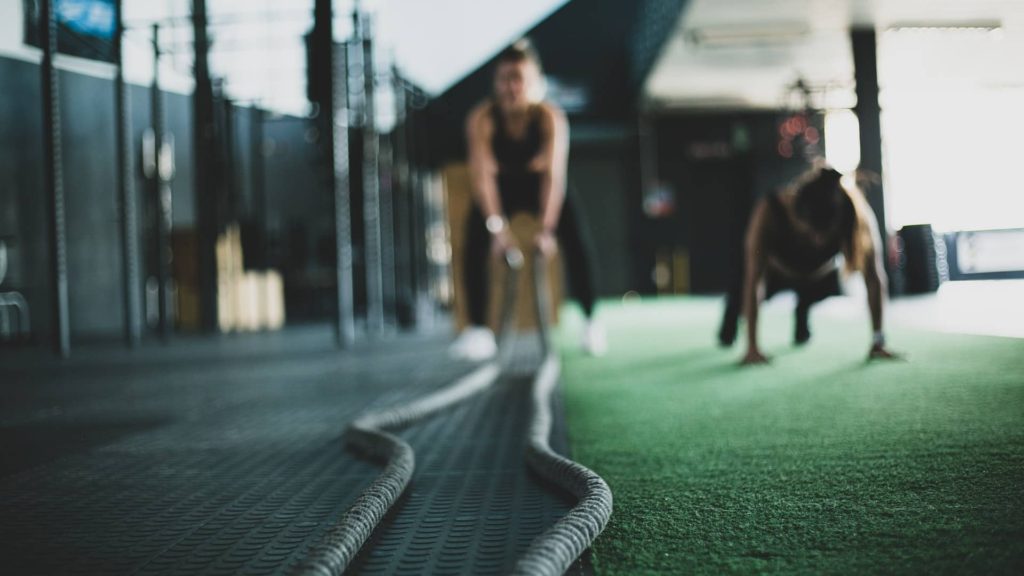
Because of how conditioning is viewed, it is often misapplied with long, grueling workouts. It’s often viewed as if you’re not sweating or breathing heavily, it’s not working.
- Performing too much of the conditioning away from the sport. For example, performing a lot of cycling as a boxer, you may benefit from some of the general adaptations but the transfer to boxing fitness will be minimal.
- Performing high-intensity conditioning too often. There is only so much your body can handle.
- Only performing high-intensity conditioning. You miss the adaptations from the intensities above and below.
Piecing It Together
The times and ratios provided are only averages of the competitions and matches analysed. However, these can provide some guidelines to influence programming as to not be shooting in the dark with your set and rep prescription.
When conditioning for any martial art, perform as much of the conditioning executing the technical skills of the sport. Sure, there is a place for traditional conditioning modalities as you don’t spend every session on the mats or in the ring.
Use a ‘funnel system’ where you start on low end conditioning (long duration, steady state drills in a repetitive fashion) while simultaneously addressing high output training (power striking, explosive takedowns) with plenty of rest. This is known as an alactic aerobic model.
As you progress closer to the middle of the ‘funnel,’ you can piece together the higher and lower intensity activity by manipulating the effort:pause ratio of your martial art. The last few weeks of fight preparation can be geared towards anaerobic lactic training as it can be maximized in such a short time period.
Almost all of your training year-round should fall into the category of aerobic alactic. Maximizing these energy systems will develop your most explosive abilities and your ability to repeat them over long durations.
References
1. UFCPI: The Cross Sectional Performance Analysis And Projection Of The UFC Athlete.
15. Ultimate MMA Conditioning – Joel Jamieson
16. Lyle McDonald Endurance Series
17. Tabata, I., Nishimura, K., Kouzaki, M., Hirai, Y., Ogita, F., Miyachi, M., & Yamamoto, K. (1996). Effects of moderate-intensity endurance and high-intensity intermittent training on anaerobic capacity and VO~ 2~ m~ a~ x. Medicine and science in sports and exercise, 28, 1327-1330.
18. SCHUMACHER, Y. O., & MUELLER, P. (2002). The 4000-m team pursuit cycling world record: theoretical and practical aspects. Medicine & Science in Sports & Exercise, 34(6), 1029-1036.
19. Laursen, P. B. (2010). Training for intense exercise performance: high‐intensity or high‐volume training?. Scandinavian journal of medicine & science in sports, 20, 1-10.
20. Weston, A. R., Myburgh, K. H., Lindsay, F. H., Dennis, S. C., Noakes, T. D., & Hawley, J. A. (1996). Skeletal muscle buffering capacity and endurance performance after high-intensity interval training by well-trained cyclists. European journal of applied physiology and occupational physiology, 75(1), 7-13.

